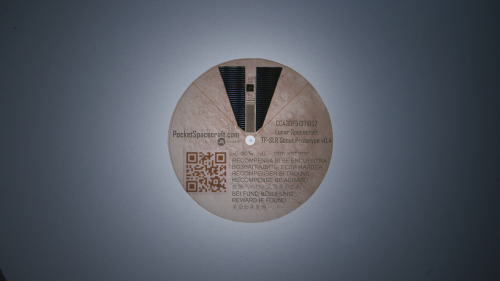By James Dacey

Photograph of a prototype Pocket Spacecraft: Thin-Film Scout
If you’re looking for a gift idea for a budding Buzz Aldrin then you might want to read on. A new crowd-funding initiative is offering the general public the chance to launch and control our own miniature missions to the Moon. Apparently, we are being given the chance to personalize our own “pocket spacecraft” that will hitch a ride on a commercial rocket before breaking free and spiralling down onto the lunar surface.
The project is the brainchild of some of the people behind the first space mission funded on KickStarter – a website that allows creative ventures to raise funds from the public. That initial project, called KickSat, offered people the chance to launch miniature satellites into the Earth’s atmosphere. It was a success and the mini satellites will be launched via a NASA mission later this year. This latest project is also being run through KickStarter and this time round we can send our space machines to the Moon.
What you are buying is a thin circular spacecraft that looks a bit like some sort of special edition Star Trek DVD. These things are feather-light, weighing in at less than a gram, with a diameter under 8 cm and an average thickness of less than a 20th of a millimetre. These space discs are made from polyimide – a material used for flexible circuit boards – and they include solar cells and a thinned commercial off-the-shelf system-on-a-chip die.
The scale and prestige of your mission depends on your technical know-how and how deep you are willing to reach into your pockets. The basic cost of sending one of these rockets to the Moon is £199, though there is a cheaper option of £99 to purchase an “Earth Scout” that will fall back to Earth after launch to test their ability to re-enter our planet’s atmosphere. The top price is £5000 to purchase the first “Lunar Scout” to be released into low lunar orbit, though I’ve no idea if this is still available. Your craft will join thousands of these pocket spacecraft to be loaded onto an Interplanetary CubeSat Mothership, which has been designed to inexpensively piggyback on pretty much any American, European, Russian or other rocket that supports CubeSats.
Sounds great but a little bit like we are just giving these guys our cash so they can launch a load of spacecraft? Well, that’s where the personalization element comes into all of this. At the most basic level you upload a picture or message that will be printed on your own Scout spacecraft that will be sent into space. But we are told that the spacecraft have also been fitted out with integrated optical and radio transceivers and can have sensors including a single-pixel optical sensor, accelerometer, gyroscope, temperature sensor, strain gauges and more. We can customize both the hardware and the software to create our own personalized space labs, and it sounds like there are options for people of all levels of expertise.
There is also an app so we can see data from our spacecraft’s instruments as it arrives, relayed from space via a global ground station network direct to our smartphones. Apparently we’ll also be able to see where our craft is at any given time by pointing our phones to the sky and using an augmented reality feature to point out exactly where our craft is in the sky. With all this fun to be had, the price tag is starting to sound like a bargain.
The only downer on the project’s webpage is where it says that we “need to be comfortable with the fact that rockets blow up”. Apparently 50% of the CubeSats that have been launched have failed for reasons known and unknown. But hey, I guess taking that sort of risk is part of the thrill of space exploration! You can find out more about the Pocket Spacecraft project here.
Guidelines
Show/hide formatting guidelines
this text was deletedwhere people live in harmony with nature and animals</q>
Some text